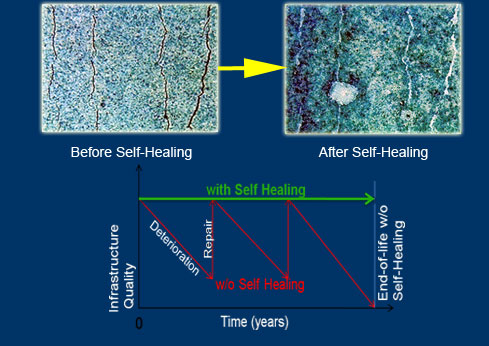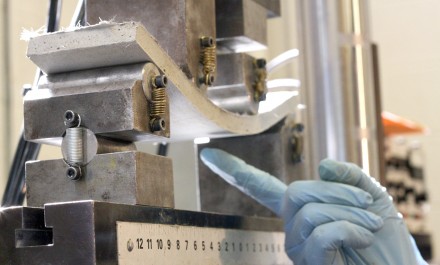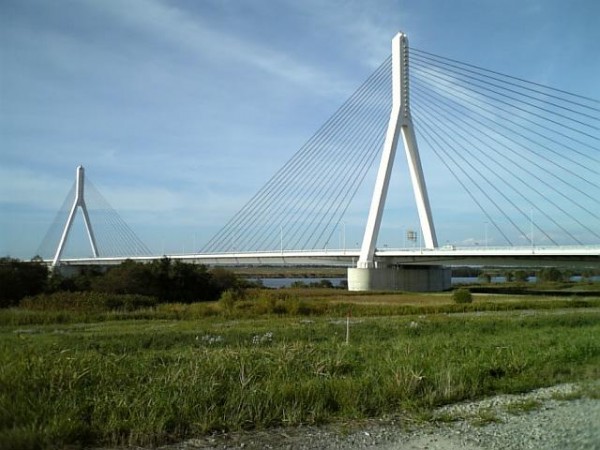You’ve probably heard about the ever-increasing backlog of US bridges needing repair or replacement. This “infrastructure debt” is also a challenge for carbon budgeting, since cement manufacture emits a lot of CO2. Any new technology that can make concrete more efficient or longer-lasting will be welcome.
We reported recently on a finding that concrete can be strengthened 32% by adding waste products from biofuel manufacture. Today’s article reviews “self-healing” concrete, a technology that’s been in the works for several years and recently got an encouraging update.

Until now, self-healing concrete schemes attempted to enhance a process that occurs on its own in concrete: the mineral calcite forms within fine cracks. (Calcite formation uses and sequesters CO2 from the air. That’s a good thing, but it only recoups a small fraction of what was emitted during cement manufacture.) Calcite can weaken rebar (steel reinforcing rods within concrete structures) but on the other hand it is denser than concrete, and strengthens the concrete itself.
Fine cracks commonly occur in concrete under stress. Water in cracks can expand them, especially if it freezes and thaws, and it can find its way to the rebar and corrode it. Calcite—or other materials—can heal very fine cracks, but most often fails to work fast enough.
A Korean team led by Chan-Moon Chung has come up with a coating that uses its own healing agent rather than calcite. Okay, since you asked, it’s called methacryloxypropyl-terminated polydimethylsiloxane. After spraying a micro-layer of polymer capsules containing the agent onto fiber-reinforced concrete, they report, “it was confirmed [microscopically] that, when the self-healing coating is damaged, the healing agent is released from ruptured microcapsules and fills the damaged region.”
They hope to make their “environmentally friendly, inexpensive, practical healing” available commercially as soon as two years from now.
Two calcite-based concepts also deserve mention. Dr. Henk Jonkers of Delft, Netherlands, works with the bacterium Sporosarcina pasteurii, long known for precipitating calcite. He mixes both live bacteria and its “food,” calcium lactate, into the concrete, and hopes the culture can survive for decades. This is a cool idea, but currently very expensive.
Also, it strikes me as a problem that once he formulates his best shot and mixes up a test batch, finding out whether the entombed bacteria will survive 40 years will take another 40 years. With the non-biological healing agents, you could test a batch under both normal and exaggerated stress loads, look closely after just a year or two, and project the next 38 years.

Victor Li of the University of Michigan introduced a fiber-bearing composite concrete in 2002 that is far less brittle than ordinary concrete. It already provides an earthquake-strong backbone for the tallest residential tower in Osaka. Such bendable concrete will naturally develop fewer and finer stress cracks, and Li has gone on working with additives than can enhance calcite formation within those hairline cracks that do form. He calculates that his concrete in bridges has a 38% lower carbon footprint than traditional concrete over 40 years, and is still structurally sound after 40 years. It was also said to reduce the concrete material used by 40% when used in the Mihara Bridge.

If we could switch to self-healing concrete by 2020 for all our bridge repairs and replacements, it could save us a lot of money on maintenance and subsequent repairs between 2030 and 2100, but it would raise the immediate cost. Sadly, the same political cheapness that gave us the present infrastructure backlog may shun any such long-term economic thinking.
I live in a part of the country where all of last-century’s bridges were designed on the assumption that we don’t get big earthquakes here. Knowing now that we do adds a jolt to the urgency of replacing our bridges. I hope that with this extra incentive, even short-term-thinking voters and politicians will like the idea of new concrete that is not only durable, but flexible.